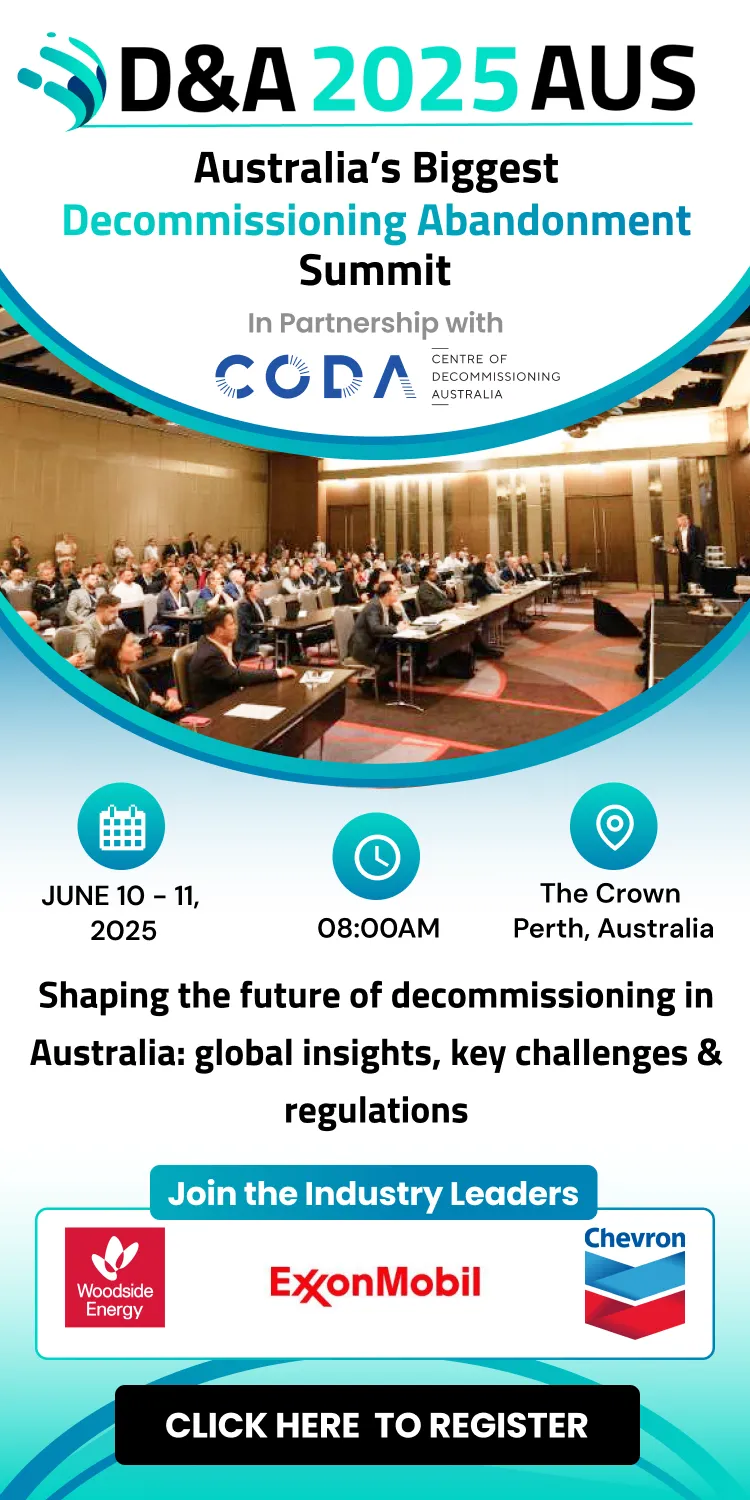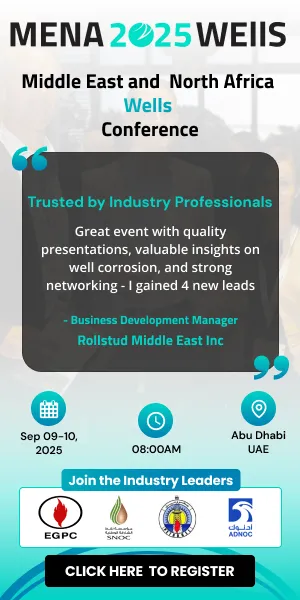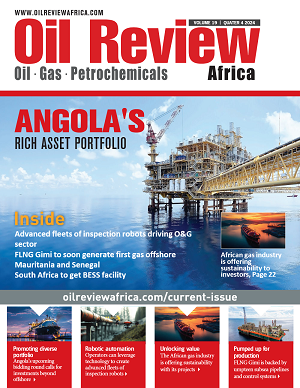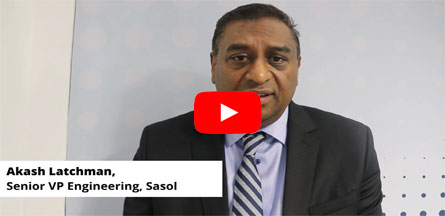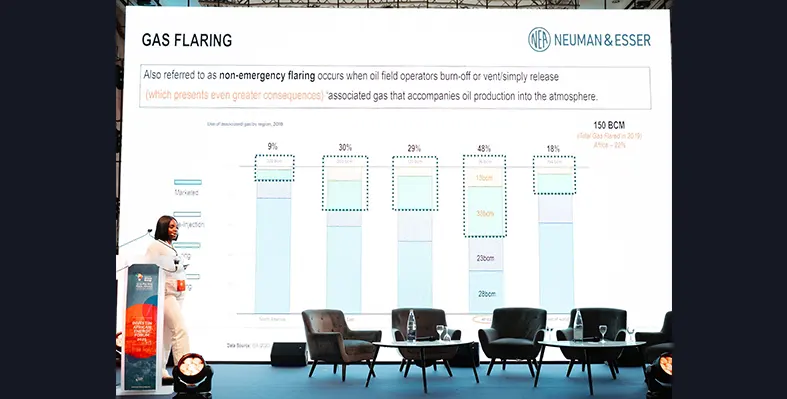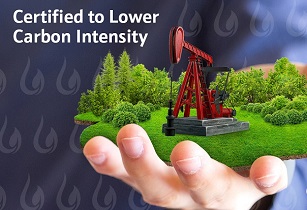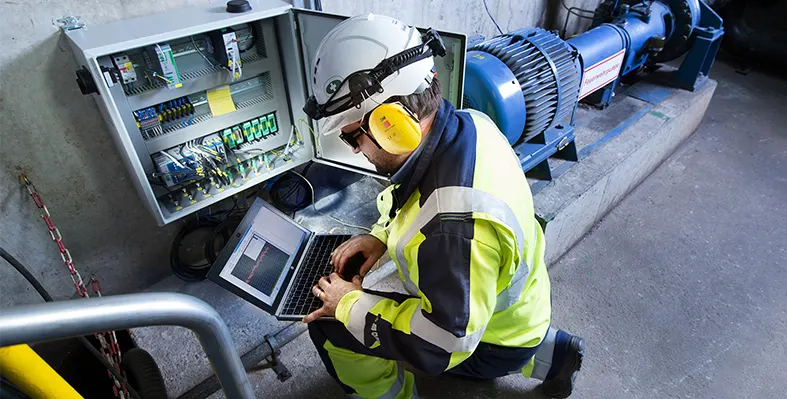In The Spotlight
With the formal approval from the South Africa Department of Mineral and Petroleum Resources for both the Exploration Right and Section 11 transfer, Eco Atlantic Oil & Gas Ltd's 75% Working Interest and full Operatorship of Block 1 offshore South Africa is now official
This acquisition, completed through Eco's wholly owned subsidiary Azinam South Africa Limited, significantly expands the Company's Southern African Orange Basin footprint and positions it as a key operator. The remaining 25% interest is held by Tosaco.
Block 1, which spans a vast 19,929 sq km, straddles the border between South Africa and Namibia. It offers full margin transect coverage from the shoreline to deepwater (shore to 263km offshore, in water depths up to 1,000m), encompassing both shallow and deepwater exploration potential.
Gil Holzman, co-founder and CEO of Eco Atlantic, said, "As the Orange Basin continues to demonstrate its world-class hydrocarbon proof and potential, Eco's executive team has worked relentlessly over the past 18 months to secure a premier asset on the South African side of the basin. With the successful approval and execution of the Exploration Right and 75% Working Interest award, we are proud to have secured one of the largest and prospective blocks in the entire basin with a known hydrocarbon footprint - Block 1 - located directly on the South Africa-Namibia maritime border. Block 1 adds to our portfolio in the Orange basin which also includes Block 3B/4B operated by TotalEnergies.
"We are grateful for the productive collaboration with the Government of South Africa and its key agencies, particularly our valued partners at the Petroleum Agency South Africa ("PASA"). I was honoured to attend the signing ceremony yesterday at PASA's offices in Cape Town. This milestone reflects the dedication and strategic focus of our leadership team in securing an asset with existing hydrocarbon evidence and significant upside potential and aligning with our strategy to partner directly with governments to secure agreements in high potential secure jurisdictions and to lay groundwork for future partnerships.
"Our technical team has already begun analysing the extensive, high-quality 2D and 3D seismic, and well logs data, which materially accelerates our path to drilling while reducing early-stage exploration costs and timelines. The block's prior discoveries, including tested gas flows and oil shows, confirm the presence of an active petroleum system.
"Initial interpretation is underway, and we are in the process of delineating early leads to develop the exploration strategy. We are already seeing significant inbound interests from international oil companies and mid-tier partners. As a result, we anticipate launching a formal farm-out process in August with further updates to follow in due course."
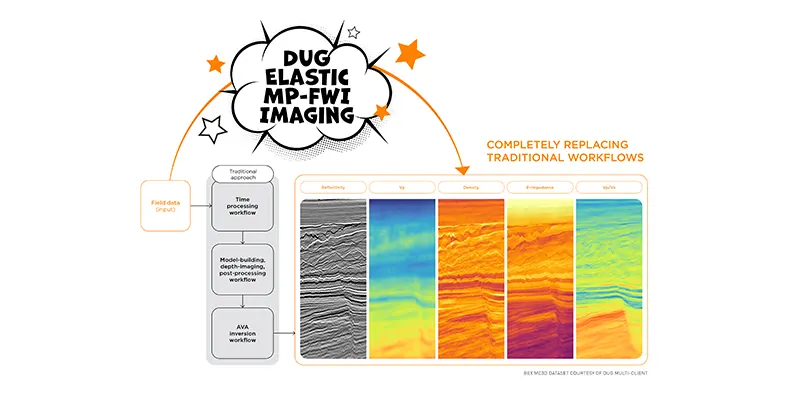
DUG Elastic MP-FWI Imaging is a unique approach to seismic processing and imaging. (Image source: DUG)
DUG has released the latest results from its elastic multi-parameter full waveform inversion (MP-FWI) imaging technology which it launched in 2022, since when more than 70 successful projects have been completed worldwide
DUG Elastic MP-FWI Imaging is a unique approach to seismic processing and imaging which is not only a complete replacement for the traditional processing and imaging workflows, it also replaces the subsequent inversion workflow for elastic rock properties.
With the traditional processing workflow, projects can take many months to years to complete. It involves the testing and application of dozens of steps such as deghosting, designature, demultiple and regularisation, all designed to overcome the limitations of conventional imaging. These workflows are complex, subjective, and very time-consuming and they rely on many assumptions and simplifications. All of these issues impact the output data quality. The resulting, primary-only data then undergoes a similarly complex model-building workflow to derive an estimate of the subsurface velocity, which is used for depth imaging. Post-migration processing is performed before the pre-stack reflectivity undergoes another workflow to derive rock properties that feed into interpretation, also relying on simplifications of the actual physics.
As well as three-component reflectivity and velocity, DUG Elastic MP-FWI Imaging enables the estimation of fundamental rock properties like P-impedance, density and Vp/Vs from field data, without the need for a secondary amplitude variation with angle (AVA) inversion step. DUG Elastic MP-FWI Imaging simultaneously resolves not only subsurface structural features but also quantitative rock property information while avoiding the need for extensive data pre-processing and (post-imaging) AVA-inversion workflows.
“Elastic MP-FWI Imaging accounts for both compressional and shear waves, handling variations in seismic wave dynamics as a function of incidence angle, including in the presence of high impedance contrasts and onshore near-surface geological complexity,” said Tom Rayment, DUG chief geophysicist. “Multiples and converted waves are now treated as valuable additional signal, increasing sampling, resolution and constraining the inverted parameters.”
DUG managing director, Dr Matthew Lamont, added, “We have invested over a decade of R&D to realise this opportunity. Our new Elastic MP-FWI Imaging technology is the product of a multi-year, significant and ongoing R&D effort, which has seen the continuous integration of complete-physics FWI imaging including viscoelasticity, anisotropy and multi-parameter updates. When using the full wavefield for simultaneous velocity model building, rock property inversion and true-amplitude imaging, a multi-parameter solution is a necessity.”
“The fact that DUG MP-FWI Imaging is delivering material imaging uplifts using field-data input is very powerful, but to couple this with high-resolution elastic rock property outputs for quantitative interpretation is even more exciting, providing immediate opportunities for new surveys and maximising the value of legacy datasets,” said Martin Stupel, geophysical manager, Geophysical Pursuit Inc.
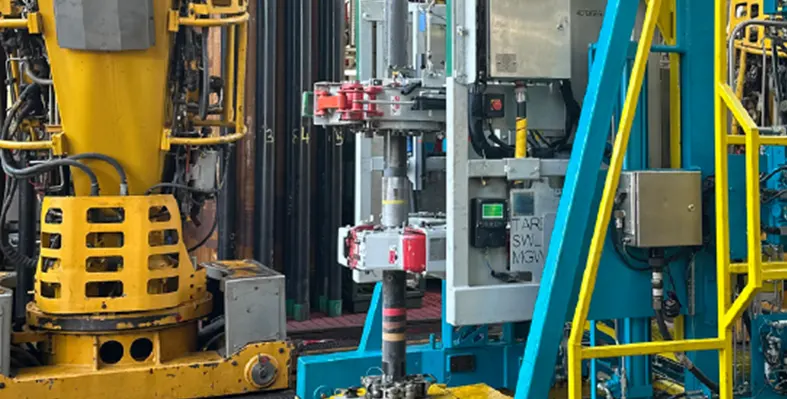
The technologically advanced tong system has simplified the well construction process. (Image source: Expro)
As Eni advances exploration activities in the Baleine field offshore Cote d'Ivoire, it onboarded Expro for its autonomous iTONG system to ensure operational safety, efficiency, and sustainability
The technologically advanced tong system has simplified the well construction process by eliminating considerable rig time and labour time, keeping personnel away from the hazardous Red Zone of the rig floor. Less rig time further brought down the net CO₂ emissions.
By automating the connection make-up and break-out of casing and tubing joints, iTONG provides precise torque control from the push of a single button - operated safely from the driller’s cabin - while enabling full connection make-up validation.
Expro secured the Tubular Running Services (TRS) contract aboard the Deep Value Driller (DVD) drillship, which arrived in Cote d'Ivoire in late 2023.
Jeremy Angelle, vice president of well construction, said, “Since its introduction to Norway four years ago, iTONG has been recognised by major operators as a top-tier solution for tubular connection make-up and validation.
“In this case, its performance has exceeded expectations, with a 50% reduction in make-up times. The vision and commitment demonstrated by both Eni and Expro in introducing this technology to Africa exemplify a shared dedication to safer, more efficient operations.”
Jeremy added, “iTONG continues to redefine industry standards, improving safety, efficiency, and cost-effectiveness for offshore operations worldwide. Thanks to cutting-edge systems like iTONG, our R&D teams are leading the TRS industry in enhancing safety, reducing emissions, and driving global cost savings.”
The West African Energy Summit
Dates: 3-5 September 2024
Venue: Accra International Conference Centre
Website: https://waesummit.com/
Ahead of the Kavango West 1X well excavation offshore Namibia, Reconnaissance Energy Africa Ltd has issued a public offering of its units following an agreement with Research Capital Corporation as the lead underwriter and sole bookrunner
BW Energy Limited, and directors and management members of ReconAfrica, among other investors, have generously responded to the offering. While BW Energy has already been on a strategic partnership with ReconAF, its fresh batch of investments in the company represents approximately 20% of the offering, increasing its share ownership position in ReconAfrica to around 7.6%.
The net proceeds from the offering will drive exploration activities -- mainly the Kavango West 1X well -- working capital and general corporate purposes. Work on the access road and drill site is currently being completed while the company awaits receipt of the remaining requisite permits. The rig move to the Kavango West 1X well drilling location is scheduled later this month, with drilling to begin thereafter.
Brian Reinsborough, president and CEO of ReconAfrica said, "We are excited to spud one of the Company's largest and most attractive prospects, Kavango West 1X. The results of the Naingopo exploration well announced in January 2025 increased our confidence in the potential for this well. Our teams remain very engaged with local communities and authorities to ensure a safe and efficient operation of this well."
Carl K Arnet, BW Energy CEO, said, "Our technical and operational teams at BW Energy are delighted to be participating in the high potential Kavango West 1X exploration well. BW Energy is well positioned in this strategically important energy region and further our position as a leader in Namibia's development towards energy independence. The data and insights gained through ReconAfrica's exploration campaign will further our understanding of the geology and petroleum system in Namibia and help de-risk planned exploration and development of our Kudu licence."

DUG Elastic MP-FWI Imaging is a unique approach to seismic processing and imaging. (Image source: DUG)
DUG has released the latest results from its elastic multi-parameter full waveform inversion (MP-FWI) imaging technology which it launched in 2022, since when more than 70 successful projects have been completed worldwide
DUG Elastic MP-FWI Imaging is a unique approach to seismic processing and imaging which is not only a complete replacement for the traditional processing and imaging workflows, it also replaces the subsequent inversion workflow for elastic rock properties.
With the traditional processing workflow, projects can take many months to years to complete. It involves the testing and application of dozens of steps such as deghosting, designature, demultiple and regularisation, all designed to overcome the limitations of conventional imaging. These workflows are complex, subjective, and very time-consuming and they rely on many assumptions and simplifications. All of these issues impact the output data quality. The resulting, primary-only data then undergoes a similarly complex model-building workflow to derive an estimate of the subsurface velocity, which is used for depth imaging. Post-migration processing is performed before the pre-stack reflectivity undergoes another workflow to derive rock properties that feed into interpretation, also relying on simplifications of the actual physics.
As well as three-component reflectivity and velocity, DUG Elastic MP-FWI Imaging enables the estimation of fundamental rock properties like P-impedance, density and Vp/Vs from field data, without the need for a secondary amplitude variation with angle (AVA) inversion step. DUG Elastic MP-FWI Imaging simultaneously resolves not only subsurface structural features but also quantitative rock property information while avoiding the need for extensive data pre-processing and (post-imaging) AVA-inversion workflows.
“Elastic MP-FWI Imaging accounts for both compressional and shear waves, handling variations in seismic wave dynamics as a function of incidence angle, including in the presence of high impedance contrasts and onshore near-surface geological complexity,” said Tom Rayment, DUG chief geophysicist. “Multiples and converted waves are now treated as valuable additional signal, increasing sampling, resolution and constraining the inverted parameters.”
DUG managing director, Dr Matthew Lamont, added, “We have invested over a decade of R&D to realise this opportunity. Our new Elastic MP-FWI Imaging technology is the product of a multi-year, significant and ongoing R&D effort, which has seen the continuous integration of complete-physics FWI imaging including viscoelasticity, anisotropy and multi-parameter updates. When using the full wavefield for simultaneous velocity model building, rock property inversion and true-amplitude imaging, a multi-parameter solution is a necessity.”
“The fact that DUG MP-FWI Imaging is delivering material imaging uplifts using field-data input is very powerful, but to couple this with high-resolution elastic rock property outputs for quantitative interpretation is even more exciting, providing immediate opportunities for new surveys and maximising the value of legacy datasets,” said Martin Stupel, geophysical manager, Geophysical Pursuit Inc.

The technologically advanced tong system has simplified the well construction process. (Image source: Expro)
As Eni advances exploration activities in the Baleine field offshore Cote d'Ivoire, it onboarded Expro for its autonomous iTONG system to ensure operational safety, efficiency, and sustainability
The technologically advanced tong system has simplified the well construction process by eliminating considerable rig time and labour time, keeping personnel away from the hazardous Red Zone of the rig floor. Less rig time further brought down the net CO₂ emissions.
By automating the connection make-up and break-out of casing and tubing joints, iTONG provides precise torque control from the push of a single button - operated safely from the driller’s cabin - while enabling full connection make-up validation.
Expro secured the Tubular Running Services (TRS) contract aboard the Deep Value Driller (DVD) drillship, which arrived in Cote d'Ivoire in late 2023.
Jeremy Angelle, vice president of well construction, said, “Since its introduction to Norway four years ago, iTONG has been recognised by major operators as a top-tier solution for tubular connection make-up and validation.
“In this case, its performance has exceeded expectations, with a 50% reduction in make-up times. The vision and commitment demonstrated by both Eni and Expro in introducing this technology to Africa exemplify a shared dedication to safer, more efficient operations.”
Jeremy added, “iTONG continues to redefine industry standards, improving safety, efficiency, and cost-effectiveness for offshore operations worldwide. Thanks to cutting-edge systems like iTONG, our R&D teams are leading the TRS industry in enhancing safety, reducing emissions, and driving global cost savings.”
South Africa has proposed importing liquefied natural gas from the United States over a 10-year period, likely affected by the US' President Donald Trump's tough tariff measures
The development was announced via a document signed by Minister in the Presidency, Khumbudzo Ntshavheni. It said that South Africa's import limits range around 75 to 100 mn cu/m of LNG per year from the US which remains the leading LNG exporter.
This move is believed to unlock for South Africa approximately US$900mn to US$1.2bn in trade per annum and US$9bn to US$12billion for 10 years based on applicable price.
The arrangement was presented by South Africa during President Cyril Ramaphosa's recent visit to the White House.
Ntshavheni, who was part of the government delegation to Washington, said that South Africa is keen on a US collaboration in technologies, including fracking, to advance gas production in South Africa.
While Mozambique currently serves as South Africa's primary source of gas import, its supply reliability might not remain as solid down the line. The potential deal with the US can help fill this gap.
South Africa is said to have considerable gas resources in the Karoo region, but it remains off limits by a moratorium on shale gas exploration due to environmental concerns.
"(South Africa) and the US will negotiate an arrangement to facilitate LNG imports from the US at the appropriate price. This will not replace our current suppliers of gas but complement those supplies," said Ntshavheni.
A thriving local refining sector requires a skilled workforce, which translates into job creation across various levels, from engineers and technicians to construction workers and administrative staff
The development of local refineries can also stimulate growth in related industries, such as transportation, logistics and service sectors, further amplifying employment opportunities.
Building a robust petrochemicals industry enables countries to diversify their economies. Petrochemicals serve as essential inputs for numerous sectors, including agriculture (fertilisers), manufacturing (plastics), and pharmaceuticals. By investing in this industry, countries can reduce their reliance on a single commodity – oil – and create a more resilient economic structure.
By minimising crude oil exports and focusing on value addition, nations can create jobs and stimulate economic growth. This comprehensive strategy not only enhances national wealth but also contributes to the overall well-being of African populations, aligning economic success with social progress.
The concept of ‘profit versus purpose’ serves as a guiding principle in the ongoing debate about energy policy. This framework integrates economic objectives with social and environmental goals, demonstrating that financial success and societal benefit are not mutually exclusive. By prioritising investments that address energy poverty and promote social equity, businesses can contribute to the continent's sustainable development while remaining economically viable.
Investing in energy solutions in underserved regions presents unique challenges, including high initial costs and limited access to traditional financing. However, these challenges also create opportunities for innovative financing mechanisms. Multilateral finance institutions and climate finance initiatives can play the central role in mobilising resources and sharing financial burdens.
Shared value mechanisms allow companies to align their business operations with social impact goals, unlocking new market opportunities while addressing critical issues like energy access. Investing in off-grid renewable energy solutions, for instance, can enable companies to tackle energy poverty while expanding their market reach.
The pathway to unlocking Africa’s oil and gas potential lies in balancing effective governance with the principles of profit for purpose. African governments must create policies that not only attract sustainable investment but also prioritise the welfare of their citizens.
By implementing transparent frameworks, favourable fiscal terms, and innovative financing models, African countries can harness their natural resources for the greater good. This collective responsibility to promote sustainable development will ensure that the benefits of oil and gas investments extend beyond profit, enriching communities and driving long-term economic growth across the continent.
This is the last of a two-part article written by Taona Kokera, director - head of infrastructure finance advisory at Forvis Mazars in South Africa
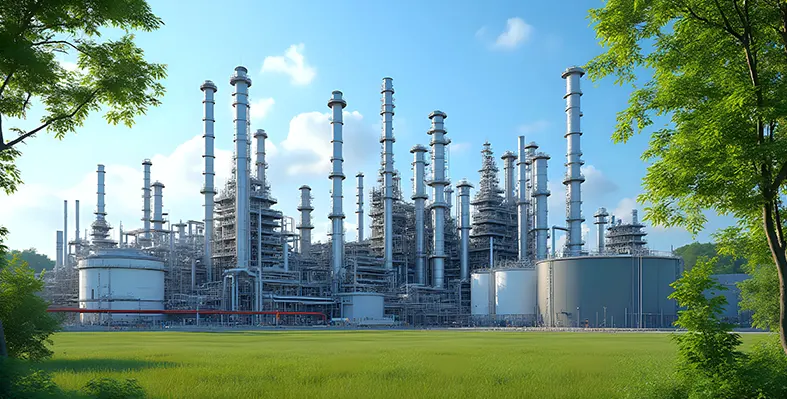
Environmental sustainability is non-negotiable while resource extraction. (Image source: Adobe Stock)
Organised by the Petroleum Authority of Uganda (PAU), the third Civil Society Organisation (CSO) Conference on Oil and Gas saw key stakeholders pledge enhanced collaboration and mutual understanding to advance best practice in business and human rights in Uganda’s extractive industry
Ernest Rubondo, executive director of the PAU, said, "We’ve made significant progress thanks to stakeholder alignment across most activities. However, differences have emerged – particularly around business, social, and human rights perspectives. It’s crucial that even in disagreement, we foster constructive engagement that promotes learning without hindering Uganda’s socio-economic development."
"As we advance in resource extraction, human rights, environmental sustainability, and equitable benefit sharing are non-negotiable. Our development strategy must integrate social safeguards, uphold dignity, and promote justice, especially for communities in project areas," said Frank Mugisha, Ag. Commissioner for the Petroleum Department at the Ministry of Energy and Mineral Development (MEMD).
TotalEnergies’ general manager, Philippe Groueix, highlighted the company's agricultural programmes to support local communities as they undertake the Tilenga Project.
“At TotalEnergies, we remain committed to a culture of active listening, learning and continuous improvement. We are not here to meet minimum standards – but to strive to set new benchmarks in the responsible energy development of the Tilenga Project,” he said.
John Bosco Habomugisha, deputy managing director of EACOP, said, “We value the role of civil society in promoting accountability and compliance. EACOP is committed to strengthening collaboration – on worker rights, grievance mechanisms, gender-responsive policies, and Business and Human Rights awareness.”








